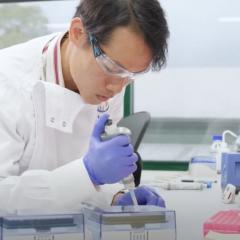The University of Queensland's Centre for Clinical Research has received $2 million in funding from the Australian Cancer Research Foundation (ACRF) for state-of-the-art imaging equipment that will improve the diagnosis and treatment of cancer in patients.
The grant will be used to help establish the ACRF Molecular Oncology Translational Imaging Facility at Herston, Brisbane, in particular, as a contribution towards the purchase of a PET/CT machine and costs associated with housing hybrid scanners, including an MRI/PET hybrid scanner, within the facility.
The analysis of brain tumours, head and neck cancers, ovarian and prostate cancers will be a particular focus of the research team, led by Associate Professor Stephen Rose.
Clinical trials will also be conducted within the facility to assess the performance of new cancer drugs.
Professor Rose, Honorary Principal Research Fellow at UQCCR, said the availability of hybrid scanners had the potential to revolutionise cancer research and patient treatment through the application of improved diagnostic and therapeutic strategies.
“Current imaging methods, such as MRI, don't always allow accurate detection of where the tumour or metastases exist in the body” Professor Rose said.
“With Hybrid Molecular Imaging Technology – combining two different types of scanners within a single scanner – we'll be able to locate where the tumour is in the body and biological information about the cancer to improve diagnosis, optimise treatment planning and monitor whether therapy is working.”
Professor Rose said the new hybrid scanners are particularly important for imaging organs that move in the body, particularly prostate, ovarian, liver and lung tumours.
“One of the problems of imaging cancer with organs that move in the body, such as the liver, is that the quality of image degrades with motion. An important feature of hybrid scanning with MRI/PET is that the motion of organs can be tracked and corrected to provide better quality metabolic images,” he said.
With both MRI/PET and PET/CT hybrid scanners under one roof, Professor Rose said the new imaging facility will be the only one of its kind in Australia and one of only a handful in the world.
“The ACRF Molecular Oncology Translational Imaging Facility will put UQCCR in a position to perform ground-breaking oncology research by utilising cutting-edge imaging technology," he said.
"It will open new funding opportunities with the NHMRC and commercial partners and attract top cancer researchers to Herston campus."
Executive Dean of the UQ Faculty of Health Sciences Professor Nick Fisk said the imaging grant is a solid example of collaboration between Royal Brisbane Women's Hospital, Queensland Institute of Medical Research, The University of Queensland and Queensland University of Technology on the Herston Campus.
"The molecular scanning equipment will improve patient outcomes through earlier diagnosis and tailored treatment, accelerate clinical trials to get new therapies evaluated sooner, and help develop novel approaches to tracking and destroying cancer cells," Professor Fisk said.
The ACRF Molecular Oncology Translational Imaging Facility will be located within the Herston Imaging Research Facility (HIRF) at the UQ Centre for Clinical Research, and adjacent to the Royal Brisbane and Women's Hospital.
Construction on the Herston Imaging Research Facility (HIRF) begins mid 2013.
Media: Shannah O'Brien (Marketing and Communications Officer (UQCCR), 07 3346 6041 or s.obrien13@uq.edu.au)
New imaging facility at UQ to improve cancer diagnosis
3 Dec 2012



